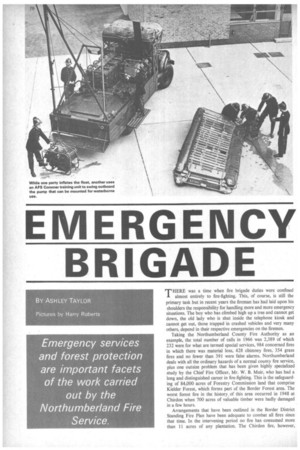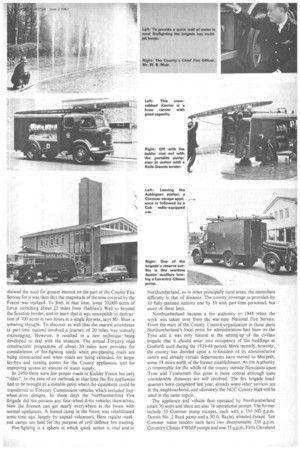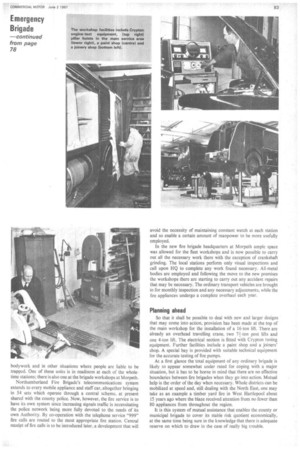EMERGENCY BRIGADE
Page 78

Page 79

Page 80

Page 85

If you've noticed an error in this article please click here to report it so we can fix it.
THERE was a time when fire brigade duties were confined almost entirely to fire-fighting. This, of course, is still the primary task but in recent years the fireman has had laid upon his shoulders the responsibility for handling more and more emergency situations. The boy who has climbed high up a tree and cannot get down, the old lady who is shut inside the telephone kiosk and cannot get out, those trapped in crashed vehicles and very many others, depend in their respective emergencies on the firemen.
Taking the Northumberland County Fire Authority as an example, the total number of calls in 1966 was 2,389 of which 232 were for what are termed special services, 984 concerned fires in which there was material loss, 428 chimney fires, 354 grass fires and no fewer than 391 were false alarms. Northumberland deals with all the ordinary hazards of a normal county fire service, plus one outsize problem that has been given highly specialized study by the Chief Fire Officer, Mr. W. B. Muir, who has had a long and distinguished career in fire-fighting. This is the safeguarding of 84,000 acres of Forestry Commission land that comprise Kielder Forest, which forms part of the Border Forest area. The worst forest fire in the history, of this area occurred in 1948 at Chirdon when 700 acres of valuable timber were badly damaged in a few hours.
Arrangements that have been outlined in the Border District Standing Fire Plan have been adequate to combat all fires since that time. In the intervening period no fire has consumed more than 11 acres of any plantation. The Chirdon fire, however, showed the need for greater interest on the part of the County Fire Service for it was then that the magnitude of the area covered by the Forest was realized. To find, at that time, some 70,000 acres of forest stretching about 25 miles from Hadrian's Wall to beyond the Scottish border, and to learn that it was susceptible to destruction of 700 acres in two hours in a single fire was, says Mr. Muir, a sobering thought. To discover as well that the nearest attendance (a part-time station) involved a journey of 20 miles was scarcely encouraging. However, it resulted in a new technique being developed to deal with the situation. The annual Forestry road construction programme of about 30 miles now provides for consideration of fire-fighting needs when pre-planting roads are being constructed and when roads are being extended, for larger lay-bys and turning points for the County appliances, and for improving access to sources of water supply.
In 1950 there were few proper roads in Kidder Forest but only "rides". In the case of an outbreak at that time the fire appliances had to be brought to a suitable point where the equipment could be transferred to Forestry Commission vehicles which included fourwheel-drive designs. In those days the Northumberland Fire Brigade did not possess any four-wheel-drive vehicles themselves. Now the firemen can get nearly everywhere in the forest with normal appliances. A hutted camp in the forest was rehabilitated some time ago, largely by unpaid volunteers. Here regular weekend camps are held for the purpose of civil defence fire training.
Fire-fighting is a sphere in which quick action is vital and in Northumberland, as in other principally rural areas, the immediate difficulty is that of distance. The county coverage is provided by 10 fully-manned stations and by 10 with part-time personnel, but more of these later.
Northumberland became a fire authority in 1948 when the work was taken over from the war-time National Fire Service. From the start of the County Council organization in those parts Northumberland's focal point for administration had been on the Tyne and it was only natural at the setting-up of the civilian brigade that it should enter into occupancy of the buildings at Gosforth used during the 1939-48 period. More recently, however, the county has decided upon a re-location of its administrative centre and already certain departments have moved to Morpeth, some 14 miles north of the former establishment. As the Authority is responsible for the whole of the county outside Newcastle upon Tyne and Tynemouth this point is more central although quite considerable distances are still involved. The fire brigade headquarters were completed last year, already some other services are in the neighbourhood, and ultimately the NCC County Hall will be sited in the same region.
The appliance and vehicle fleet operated by Northumberland totals 70 units and there are also 74 operational pumps. The former include 10 Commer pump escapes, each with a 350-500 g.p.m. Dennis No. 2 fixed pump and a 50 ft. Bayley wheeled escape. Ten Commer water tenders each have two dismountable 250 g.p.m. Coventry Climax FWMP pumps and one 75 g.p.m. Firth Cleveland portable pump. These are supplemented by two Commer tenders, each with one 250 g.p.m. dismountable Coventry Climax FWMP pump. Next on the list come 10 Rolls-Dennis F8 water tenders, each with two dismountable 250 g.p.m. Coventry Climax FWMP pumps and one 75 g.p.m. Firth Cleveland portable pump.
Among other appliances there are six Karriers, each of which tows one 500 g.p.m. Coventry Climax large trailer pump and transports a 175 g.p.m. Firth Cleveland portable pump. These units each carry 4,500 ft. of delivery hose, there being 60 sections, each 7511. in length. General road vehicles include 13 staff cars, 11 utility vans, a stores van, four auxiliary towing vehicles, a service van and two general units. The total fleet mileage for a_ typical year is over 316,000.
According to the 1967-68 estimates, running costs for the period will amount to £10,950, this being divided into: fuel £5,910, lubricants £230, anti-freeze 167, tyres £563, batteries £388, painting £170, general repairs and maintenance £2,422 and conversions £1,200.
Water for emergencies
Water supply is a recurring problem in the work of all fire brigades operating in predominantly rural territory. For this reason the tenders incorporate 400 gal. tanks with which speedy action can be taken, perhaps preventing a fire from spreading into a serious conflagration. In order to proceed further with the work it must be possible to employ natural resources like streams and ponds. Appliances likely to be in demand in the rural areas carry the dismountable pumps which, weighing 3crwt., can be carried or possibly wheeled on small wheels over distances that may be as much as a mile. The hose tenders with their long supply lines are an essential part in the link-up. In readiness for forest fires a special form of longitudinally perforated hose has been developed with which to set up a "wall" of water that will deal most effectively with such blazes.
To give proper distribution of personnel and appliances throughout the county the brigade has 10 stations manned with full-time professional firemen and a similar number relying on part-time retained men. Fully-manned stations, in addition to Morpeth, are Newborn, Gosforth, Wallsend, Whitley Bay, Blyth, Ashington, Hexham, Alnwick and Berwick. Stations operating on a part-time personnel basis work in conjunction with the fullymanned stations. Thus, Prudhoe is linked with Newburn; Belford and Wooler are joined to Berwick; Seahouses, Rothbury and Amble link with Alnwick; Haydon Bridge, Haltwhistle, Allendale and Bellingham are joined to Hexham. To give a round-the-clock service each whole-time station requires an officer-in-charge and 26 men, the only exception being Wallsend where double availability is necessary, this demanding a total of 44 men.
To all intents and purposes the fire service is the only instantly mobile force in Britain, standing ready for action 24 hours a day, 365 days a year. This is why firemen get called to so great a variety of awkward situations when the people concerned just don't know who else could help. Harking back to what may be called the humanitarian emergency category the possibilities are legion. Typical instances include children marooned on a river island, cats that have mysteriously reached inaccessible points on high buildings, horses stuck in bogs, sheep that have fallen into old mine workings, and boys at the top of huge trees in positions from which they are quite unable to descend.
On call for rescue
Since Northumberland is very likely to suffer from gale conditions the police in their travels may observe defects developing in structures and it is the fireman who is then most likely to be called upon to remove the danger. Less spectacular but equally important are the elaborate operations that sometimes have to be devised when breakdowns have left localities entirely without water supplies. Here the fire brigade not only has the equipment but the mobility essential to the job. A valuable item for many escape operations is the Epco hydraulic rescue kit, a cutting outfit which is designed for opening up, or otherwise working on, damaged bodywork and in other situations where people are liable to be trapped. One of these units is in readiness at each of the wholetime stations; there is also one at the brigade workshops at Morpeth.
Northumberland Fire Brigade's telecommunications system extends to every mobile appliance and staff car, altogether bringing in 54 sets which operate through a central scheme, at present shared with the county police. Now, however, the fire service is to have its own system since increasing signals traffic is necessitating the police network being more fully devoted to the needs of its own Authority. By co-operation with the telephone service "999" fire calls are routed to the most appropriate fire station. Central receipt of fire calls is to be introduced later, a development that will avoid the necessity of maintaining constant watch at each station and so enable a certain amount of manpower to be more usefully employed.
In the new fire brigade headquarters at Morpeth ample space was allowed for the fleet workshops and is now possible to carry out all the necessary work there with the exception of crankshaft grinding. The local stations perform only visual inspections and call upon HQ to complete any work found necessary. All-metal bodies are employed and following the move to the new premises the workshops there are starting to carry out any accident repairs that may be necessary. The ordinary transport vehicles are brought in for monthly inspection and any necessary adjustments, while the fire appliances undergo a complete overhaul each year.
Planning ahead
So that it shall be possible to deal with new and larger designs that may come into action, provision has been made at the top of the main workshop for the installation of a 16-ton lift. There are already an overhead travelling crane, two 71-ton post lifts and one 4-ton lift. The electrical section is fitted with Crypton tuning equipment. Further facilities include a paint shop and a joiners' shop. A special bay is provided with suitable technical equipment for the accurate testing of fire pumps.
At a first glance the total equipment of any ordinary brigade is likely to appear somewhat under rated for coping with a major situation, but it has to be borne in mind that there are no effective boundaries between fire brigades when they go into action. Mutual help is the order of the day when necessary. Whole districts can be mobilized at speed and, still dealing with the North East, one may take as an example a timber yard fire in West Hartlepool about 15 years ago where the blaze received attention from no fewer than 80 appliances from throughout the region.
It is this system of mutual assistance that enables the county or municipal brigade to cover its stable risk quotient economically, at the same time being sure in the knowledge that there is adequate reserve on which to draw in the case of really big trouble.




























































































































































